Back to QMetry All Products Help Page
Copy of How to perform bulk operations on requirements?
Where to access the Bulk Operation feature for requirements?
- Open Requirements module list view.
- Click on the Con icon
 at the top right corner on the toolbar and select Bulk Operations.
at the top right corner on the toolbar and select Bulk Operations.
Note:
- The Bulk Operation option remains disabled by default if there are more than 1000 requirements.

- Bulk Operation can be performed on a maximum of 1000 requirements at a time. You can make use of different filters to search specific records based on different criteria on the grid - It will help you pick the required requirements and narrow down the requirement count and move ahead with the bulk operation.
- The filters applied on the requirements grid are carried forward on the bulk operation screen. In this way, you can easily perform bulk operations with filtered records.
- All the columns enabled on the grid are also carried forward on the bulk operation screen. You need to enable required columns on the grid from the "Arrange Columns" option to view them on the bulk operation screen.
The following bulk operation feature is provided for requirements to perform -
Bulk Edit
- Select the Edit operation you want to perform on the assets and click Next.
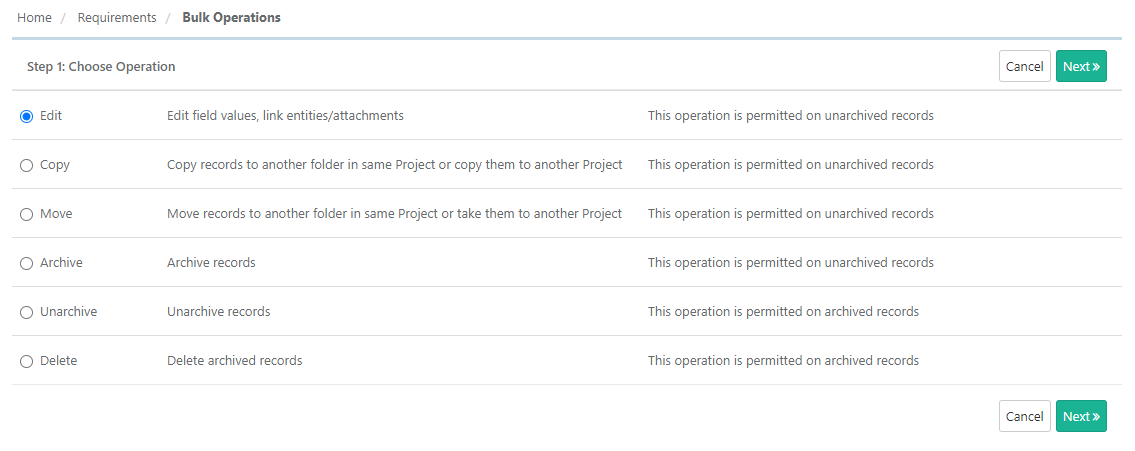
- Select records - The next screen displays records with the check box.
- Select individual assets by selecting checkboxes or choose "Select All (Across Pages | This will select Max. 1000 Records)" to perform bulk operations and then click Next.
The screen opens with system fields for editing bulk requirements. Below is the list of options you will get to edit selected requirements in bulk.
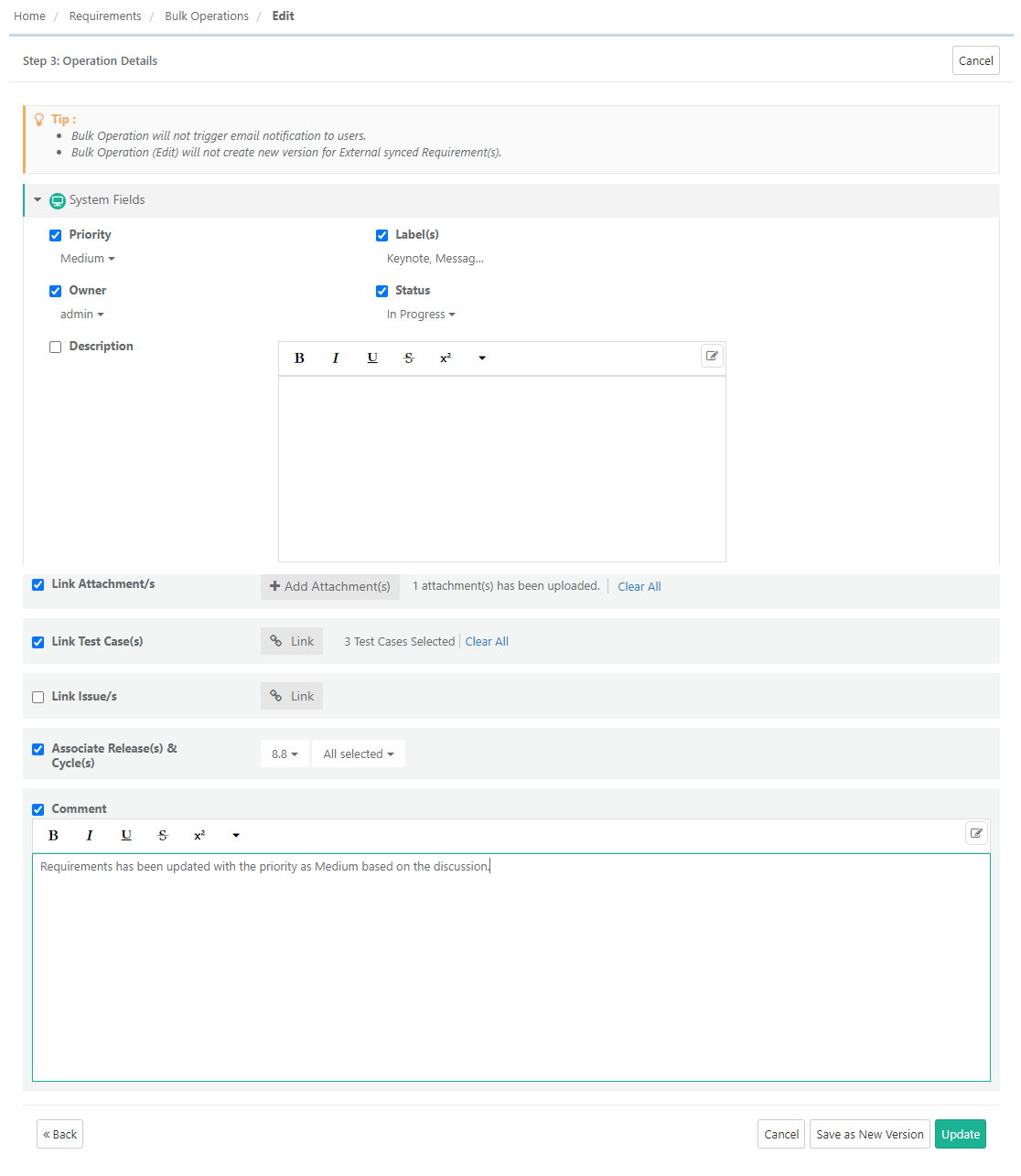
Once you are done changing field values, click either Save as New Version or Update for requirements.
- The bulk operation (Edit) will not create new versions for the external requirements.
Bulk Copy
Users can copy requirements within the project and across the project. The destination project should have the required user-defined fields that are used in the source project.
A user can move/copy the requirements to the destination folder or a root folder of the destination project.
- Go to Bulk Operations.
- Select Copy as the operation to perform and click Next.
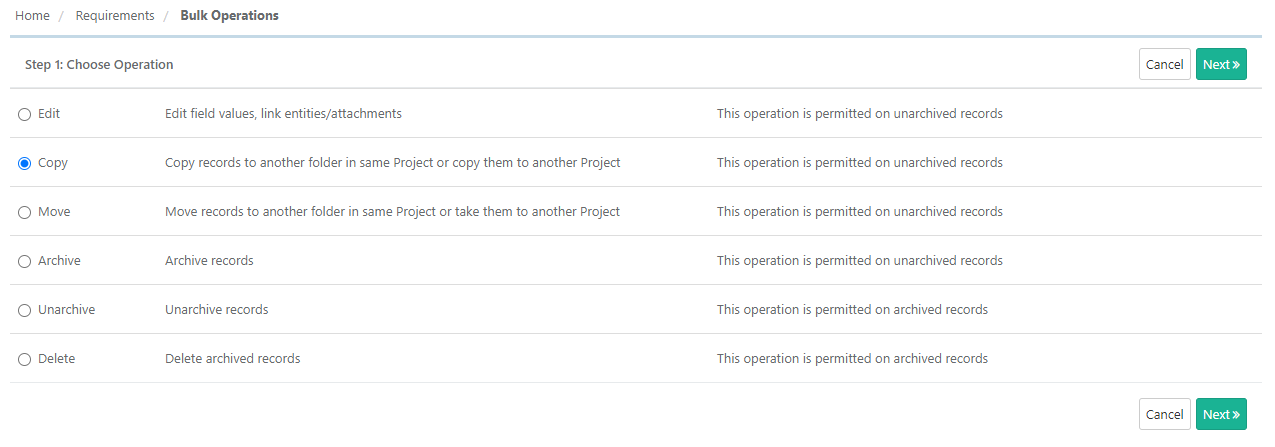
- Select requirements which are to be copied. If you want to copy all the requirements across pages then select the Select All (Across Pages) option. Maximum 1000 records can be selected at a time.
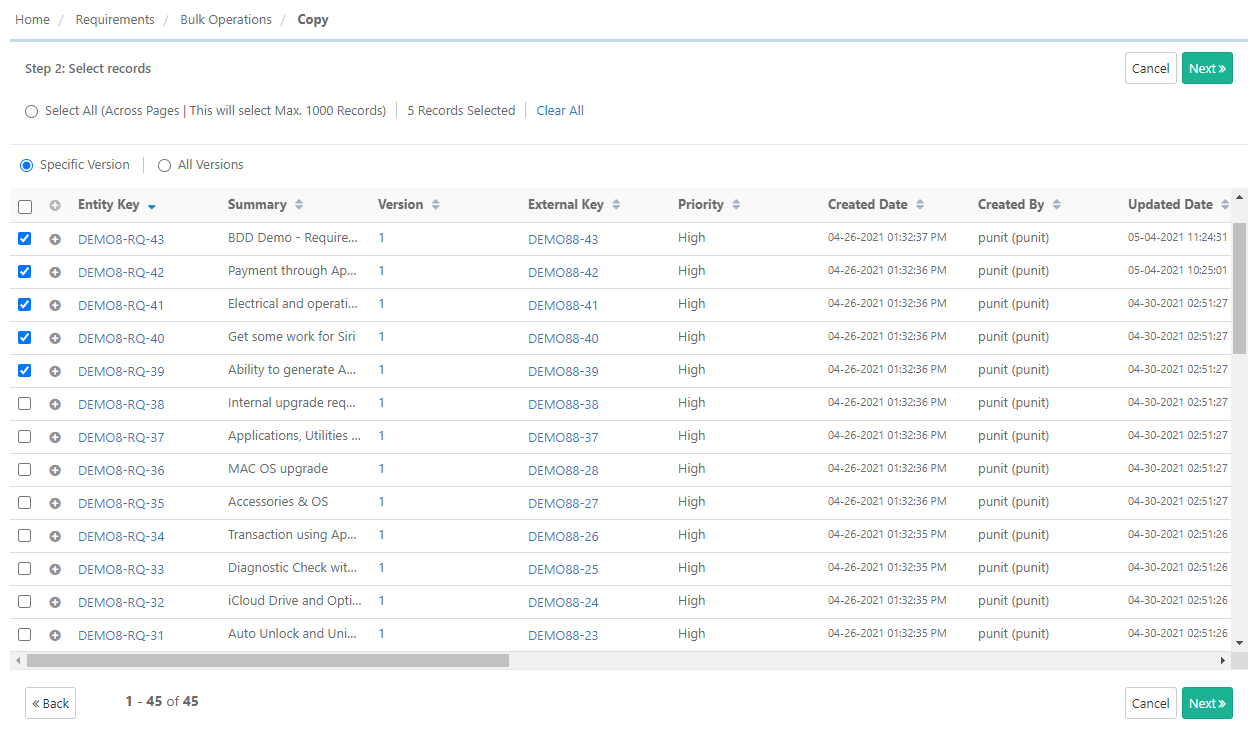
- Select requirement version options:
- Specific Version: You can select a particular Version of the requirement to copy. Requirements with multiple versions are expandable and you can view all the available versions of the requirements.
- All Versions: If this option is selected then the Version button "
 " will be disabled for requirements. Users can not select a particular version of the requirement.
" will be disabled for requirements. Users can not select a particular version of the requirement.
- Click Next.
- Operation Details:
- Project: You can copy requirements within the same project and across projects. Select the destination Project you want to copy the selected requirements to.
- Owner: Select the Owner of the requirements in the destination project. The Owner list is populated as per the Project selection.
- Folder: Select the folder in which you want to copy the selected requirements. To create a new folder in the destination project, enter the folder name in the box and click on the Add Folder button. The new folder is added to the folder tree.
- Destination Path: The Destination Path is displayed according to the folder selection on the tree.
- Click Copy.
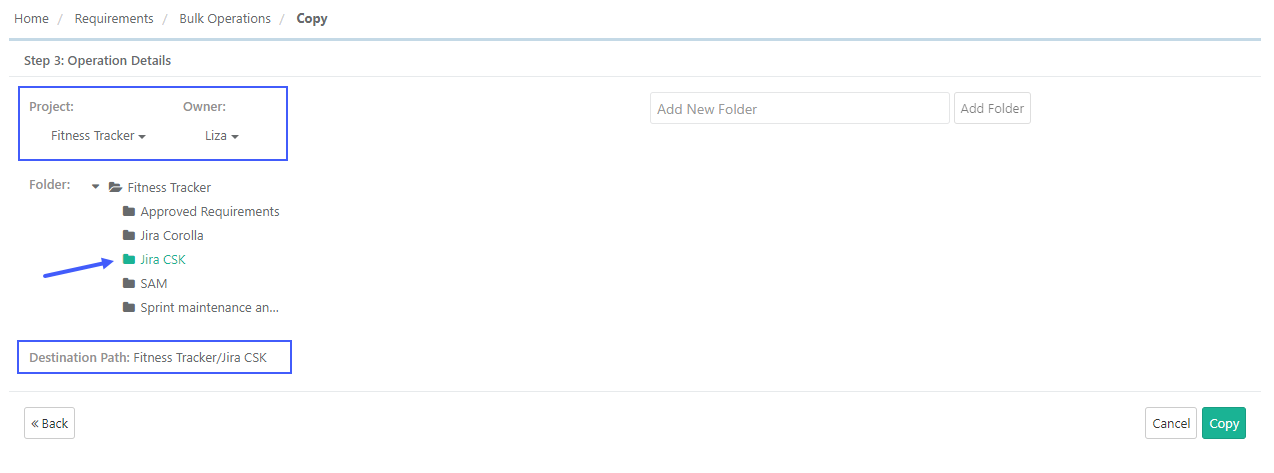
- The count of copied entities is displayed in the Scheduled Task window that can be opened by clicking on the icon on the application header.
Bulk Move
The process is the same as Bulk Copy except for the version selection. Test Assets will be moved with all their existing versions.
What will be copied/moved with test assets?
Operation | Same Project | Across Project |
|---|---|---|
| Copy | For the selected /all versions it will copy assets with all attachments, linkage of requirements, test cases, release, cycle, issues (linked with Requirement) | For the selected/all versions it will copy assets with all attachments |
| Move | For the selected /all versions it will copy assets with all attachments, linkage of requirements, test cases, release, cycle , issues (linked with Requirement ) | For the selected/all versions it will move assets with all attachments |
Bulk Archive
Archiving the requirements will hide them from the requirements default list view. The archived requirements will still exist in the project. To delete these requirements, they should be archived first. Archived requirements can be viewed by enabling the "Show Archived Items" option from requirements filters.
- Go to Bulk Operations.
- Select Archive operation and click Next.
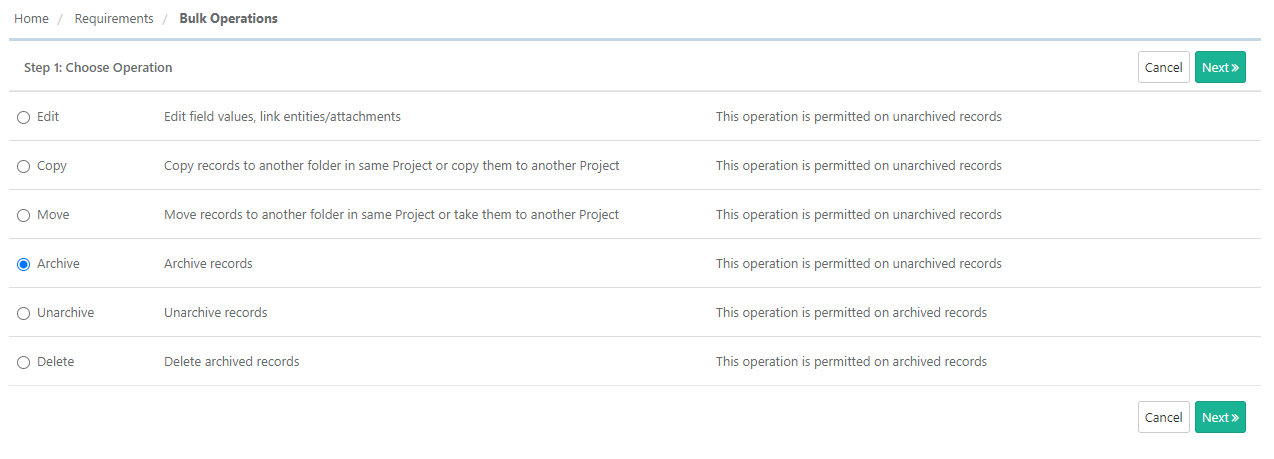
- Select requirements which are to be archived and click on the Archive button. Confirm the operation on the dialogue window.
The following operations will be available for archived assets:
- Unarchive: Unarchive selected requirements.
- Delete: Delete archived requirements.
Bulk Unarchive
Unarchive operation can be performed on archived requirements. The operation helps you unarchive a list of archived requirements based on the chosen requirements grid filter.
- Go to Bulk Operations.
- Select Unarchive operation and click Next.
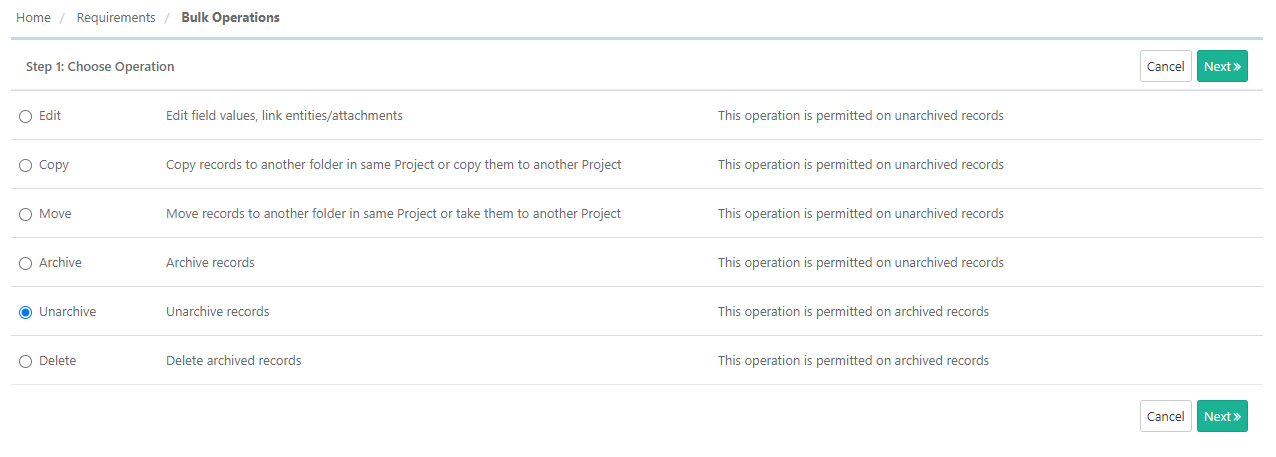
- The screen shows archived records.
- Select the records you want to unarchive and click on the Unarchive button.

Bulk Delete
To delete the requirements in QMetry, they should be archived first. It is a two steps process - Archive requirements & Delete archived requirements. Deleting the requirements will remove them permanently from the system which can't be recovered back. hence, the operation should be performed carefully.
- Select Delete operation and click Next.
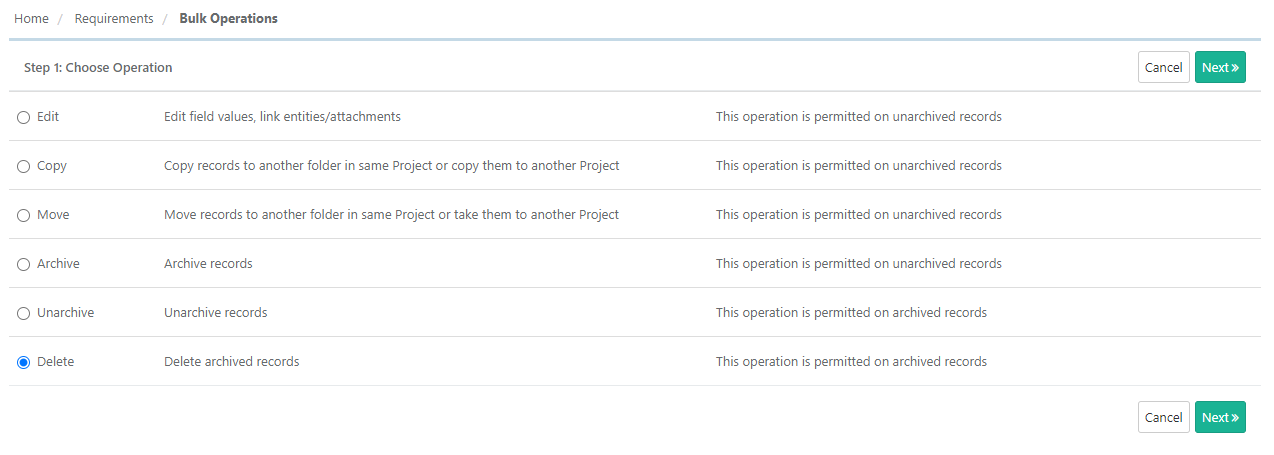
- The screen shows archived records. Select records you want to delete by checking checkboxes. To select all the records across pages select the Select All option.

- Once you are done with selecting the records, click on the Delete button. Confirm the operation on the dialogue window that pops up.
Scheduled Task
Click on the Scheduled Task ![]() icon available in the application header. The Scheduled Task icon turns Orange in color whenever any of the following actions is initialized. The icon color changes to original as soon as you click on it to view the task status.
icon available in the application header. The Scheduled Task icon turns Orange in color whenever any of the following actions is initialized. The icon color changes to original as soon as you click on it to view the task status.
- All bulk operations
- Import - IS, TC, TS, RQ
- Export - IS, TC, TS, RQ, Test execution
- Project clone
The screen shows all the activities completed or in the queue.

Back to QMetry All Products Help Page